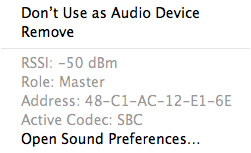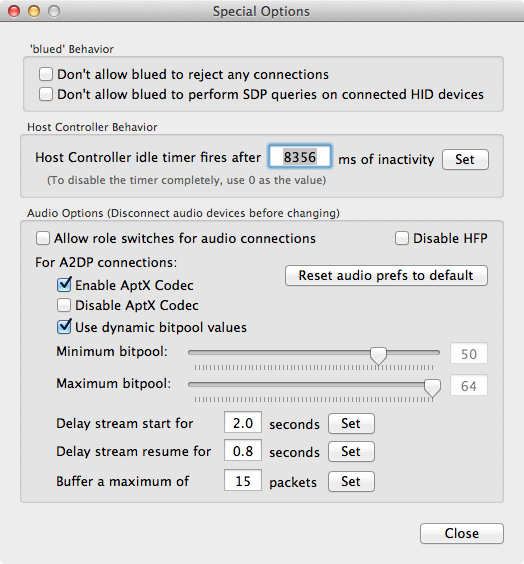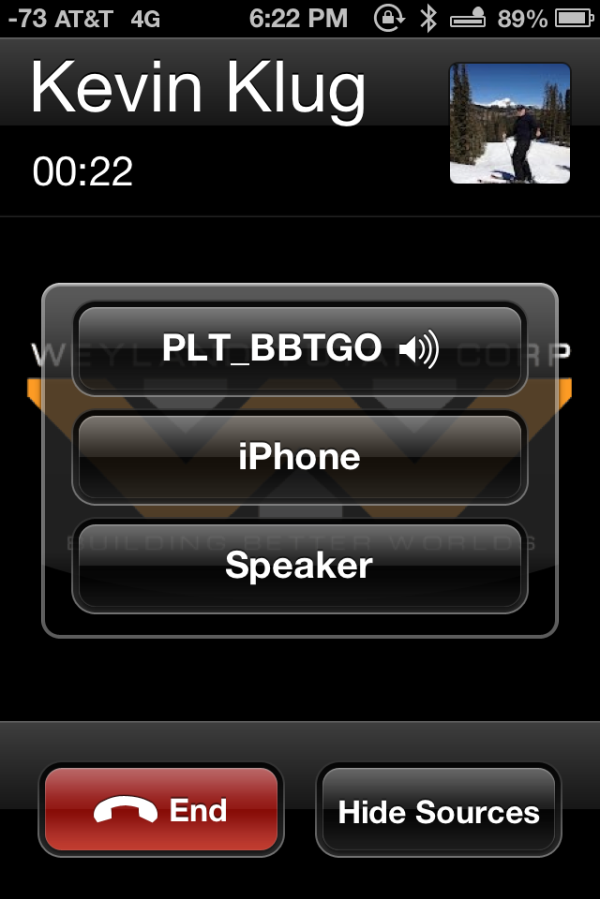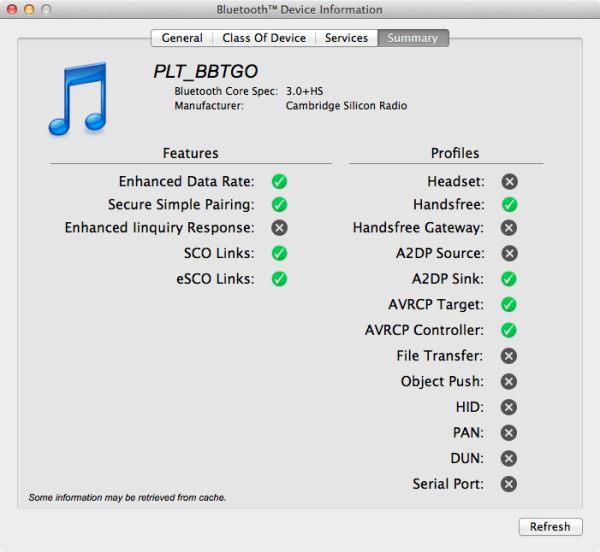Plantronics BackBeat Go Review - Almost the Perfect Bluetooth Earbuds
by Brian Klug on August 27, 2012 6:00 PM EST- Posted in
- Smartphones
- Mobile
- Bluetooth
- plantronics
Thanks to the FCC, we have some idea what’s inside the BackBeat Go headsets. It’s impressive that things have been miniaturized enough that it’s possible to cram everything required for Bluetooth 2.1 + EDR A2DP, battery, and the speaker drivers themselves into two small packages.
The two earbuds contain vastly different components. Inside the left module is the speaker driver, and a circular Li-Ion battery that takes up the rest of the volume.
The right module contains all the other circuitry required for the headsets, a small Bluetooth SoC, and a few other packages on a few boards, which in turn wrap around a center module. Unfortunately I can’t make out what controller or solution is at the center of this all.
The controller board is relatively basic as well, containing four switches and microphone.
It looks as though the BackBeat go antenna is in that right earbud module, and it’s a very small –1.8 dBi internal PCB antenna.
The BackBeat Go doesn’t support pairing to multiple devices. I’ve used the earbuds with my 2011 MacBook Pro, Windows 7 Desktop, iPhone 4S and countless Android devices (One X, One S, SGS3, Huawei Ascend P1) successfully, but you’ll have to forget and pair again to each new host device when you want to change.
The controller reports battery level, and on the iPhone you get the standard indicator with state of charge. There’s nothing really out of the ordinary about how the BackBeat Go pairs and works with Bluetooth host devices, other than that the usual split between A2DP and HFP/HSP remains, and you can’t use both functions at the same time (eg hands free operation alongside A2DP stereo audio). This means you can’t really use the BackBeat Go as a gaming headset and get stereo audio alongside the microphone, unless you fall all the way back to mono audio. At least, I wasn’t able to make this work on Windows 7 with CS:GO and my generic miniature Bluetooth dongle.

SBC Codec used
I spent a lot of time playing with the Bluetooth Explorer developer tool which is a part of Xcode on OS X. This exposes some conflicting information from the Plantronics datasheet, specifically that the core version is Bluetooth 3.0 + HS. In addition we can see the controller vendor is Cambridge Silicon Radio (CSR) which isn’t a surprise at all considering their huge presence in the Bluetooth audio peripheral space. Unfortunately I can’t identify exactly what controller is inside beyond that.
That tool also allows one to enumerate all the different Bluetooth profiles that are available. Headset isn’t available despite the datasheet including HSP in the list, though HFP is essentially the replacement for that profile. Secure simple pairing also is present, which I’d wager basically everyone is familiar with. Again you can only pair the headsets to one device at a time, multiple host pairing is not supported.
While I heard good audio quality on Windows, iPhone, and Android devices, OS X left a lot to be desired, with frequent hitching and stuttering for some reason. A trip into the special options pane in Bluetooth Explorer allows one to increase the A2DP bitpool minimum, which resolved the problem.

Oddly enough it seems as though the defaults in Mountain Lion don’t include apt-X enabled out of the box, but checking this didn’t do anything for me, again, because the BackBeat Go doesn’t support it. I find it very curious that OS X has such strange defaults considering Apple’s continual push on device makers to support the maximum bitpool for iOS Bluetooth devices.


-006_575px.jpg)
-002_575px.jpg)
-004_575px.jpg)


















31 Comments
View All Comments
SimplePhotos - Wednesday, May 29, 2013 - link
I bought a pair of these when I got my iPhone 5 back in March. I use them every day, in all life circumstances, including outdoor work as a photographer (rain & dust). I am able to have phone conversations while I take photos simultaneously on my iPhone using these things. I only paid $50 at RadioShack on discount, but I would recommend them up to $80. It's not often I find a product that is completely seamless and so reliable. At the gym, I leave my phone in a wooden locker and work out up to 50' away and never break signal. I am considering purchasing another pair off eBay for backup when the batteries run out (I generally get about 5 hours out of a charge). I don't write reviews often, but I really feel like some people are underrating this product here, and I want to share my view. For the freedom and reliability, a $70 price point is a bargain in my view. I absolutely hate 'cord snag' where buds get ripped out of my ears due to some movement... I never have to deal with that now. Hope this helps. Brian -Dariusbird - Monday, August 27, 2012 - link
How do you think these Plantronics stack up against my LG HBS-700? Just might be time for an upgrade.dsumanik - Monday, August 27, 2012 - link
I own the lg tone tones, and jaybird freedoms, the lg tones have better reception, battery life, plus the vibrating feature is nice so you can leave your phone on the table and walk around the house....not having to keep the earbuds in your ear the whole time to listen for a call.The jaybird freedoms are more sweat proof, but changing songs on them is a pain while you are jogging and the sound quality is crap.
Ive owned many headsets the hbs700 is hands down the best in almost every department, battery reception and sound quality/noise cancellation....to the point when i make a call on my regualr iPhone, people complain and say they cant hear me very well, until i switch back to the headset.
These all in one style earbuds are sleek and convenient...but you trade reception and battery life for the convenience.
Another set to check out if you like this style is novero rockaways
lockey813 - Wednesday, October 17, 2012 - link
Would you recommend the hbs700 or the bbs730? Thank youlockey813 - Wednesday, October 17, 2012 - link
sorry typo. I mean the HBS-700 or the HBS-730Bob-o - Monday, August 27, 2012 - link
With that poor battery life I think I'll stick with my Voyager 855's for now.http://www.amazon.com/dp/B000UBNFT2
Not the best audio quality. . . but who would use BT for audio quality anyway? Break out the high-quality wired set for that.
OCedHrt - Monday, August 27, 2012 - link
I'm really surprised at the recent articles on this form factor being new or some kind of break through. Sony's had this exact form factor for several years now, but obviously failed to market it (no wonder they're losing market share left and right). You can get one now for about half the price of this one (though it may be a knock-off) on eBay or something.Brian Klug - Monday, August 27, 2012 - link
Which model? Somehow I never ran into it, yet it has been the form factor I've been looking forward to for quite a while now. I guess this was my first exposure to it, for whatever reason.-Brian
Impulses - Monday, August 27, 2012 - link
The IS800 mentioned below have been around for at least three years I think, used to retail for over $200 tho. Battery life still kills the value for this form factor IMO.Rather just use a clip on receiver with longer battery life and the upside of being able to plug in the headphones directly when it runs out.Brian Klug - Monday, August 27, 2012 - link
Ahh that's a good point, hmm I really need to give those a try. I'd like to just try all of them out at once honestly, since using this form factor is something I'd like to do on a daily basis.-Brian